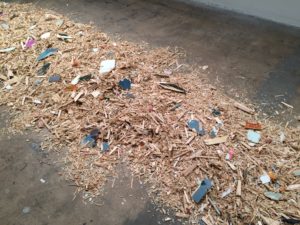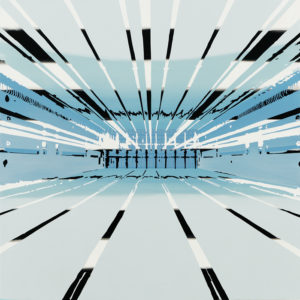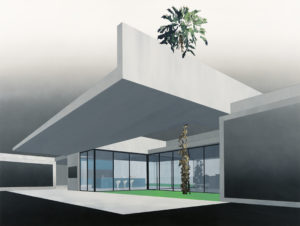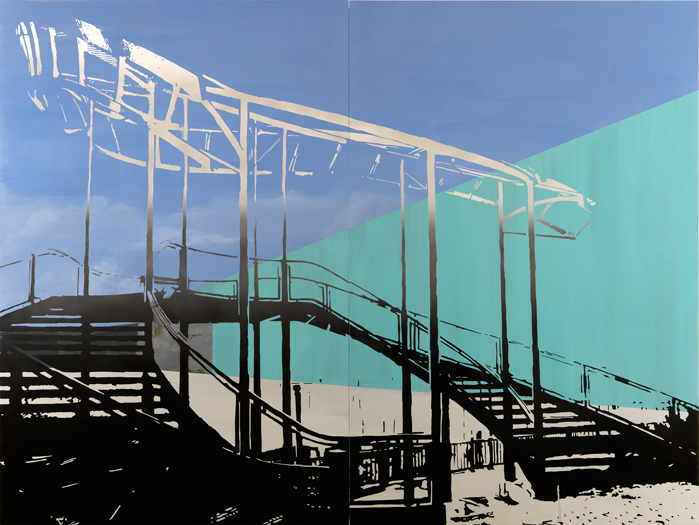Dean Monogenis destroyed nine paintings putting them on display in a work entitled Black Hole. Feeling the need to purge, Monogenis selected older pieces from the gallery’s inventory and cut them into strips to be fed into a wood chipper. He then collected the sawdust and debris for display in an elongated pile in the gallery’s project space.

Dean Monogenis, Black Hole (2017). Photograph by Jody Zellen.
In contrast, he presents a series of six new paintings in Gallery 2. The juxtaposition of transformed older work with new paintings is a curious pairing as one cannot help but wonder about the paintings that no longer exist, and why Monogenis chose to destroy them. If the absent paintings represent the past, the paintings shown under the title Catharsis are seen as a point of departure and a new beginning. One wonders, however if this conclusion is a bit too pat. Is it necessary to destroy the old to create the new? What lasting intrigue does this mound of wood chips have?

Dean Monogenis, Swimming Pool (2017), courtesy of the artist and Walter Maciel Gallery.
Far more compelling are Monogenis’ new paintings. In these works he paints architectural fragments in myriad stages of development and decay. His flattened buildings are abstractions situated against gradients of blues and grays, which double as sky. The works fuse geometric patterns with elements of the natural landscape, investigating what is tenuous and impermanent in a changing world.

Dean Monogenis, Pan American 436 (2017), courtesy of the artist and Walter Maciel Gallery.
In Swimming Pool (all works 2017) the underwater perspective is unsettling. Black and white lines representing the lanes in a pool are mirrored above and below an aqua-blue center. The painting depicts an imagined never ending space, from which there is no escape. In Long Gone, Monogenis paints a stenciled silhouette of a rounded stairway that overlooks an empty gray space abutted by a bright green wall. In Pan American 436, a lattice structure reminiscent of the ruins from the New York World’s Fair is surrounded by budding green trees. Powerhouse, a painting of an ultra-modern home similarly depicts a cold and alienating space devoid of people.

Dean Monogenis, Powerhouse (2017), courtesy of the artist and Walter Maciel Gallery.
Monogenis’ paintings suggest a world after an apocalypse. He depicts people-less places that are simultaneously futuristic and nostalgic. His ambiguous spaces allude to ruins, yet also feature nature—a sign of regeneration and life. The idea of regeneration can also be read into Monogenis’ installation, Black Hole which then situates the piece in context, making the exhibition come full circle.
Dean Monogenis, Black Hole/Catharsis, March 11 – April 29, 2017 at Walter Maciel Gallery, 2642 S. La Cienega Boulevard, Los Angeles, CA 90034, www.waltermacielgallery.com


